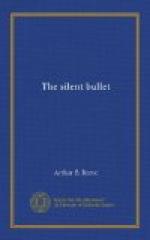The regular contests did not begin until the afternoon, but Kennedy and I decided to make a day of it, and early the next morning we were speeding out to the park where the flights were being held.
We found Charles Norton, the inventor, anxiously at work with his mechanicians in the big temporary shed that had been accorded him, and was dignified with the name of hangar.
“I knew you would come, Professor,” he exclaimed, running forward to meet us.
“Of course,” echoed Kennedy. “I’m too much interested in this invention of yours not to help you, Norton. You know what I’ve always thought of it—I’ve told you often that it is the most important advance since the original discovery by the Wrights that the aeroplane could be balanced by warping the planes.”
“I’m just fixing up my third machine,” said Norton. “If anything happens to it, I shall lose the prize, at least as far as this meet is concerned, for I don’t believe I shall get my fourth and newest model from the makers in time. Anyhow, if I did I couldn’t pay for it—I am ruined, if I don’t win that twenty-five-thousand-dollar Brooks Prize. And, besides, a couple of army men are coming to inspect my aeroplane and report to the War Department on it. I’d have stood a good chance of selling it, I think, if my flights here had been like the trials you saw. But, Kennedy,” he added, and his face was drawn and tragic, “I’d drop the whole thing if I didn’t know I was right. Two men dead—think of it. Why, even the newspapers are beginning to call me a cold, heartless, scientific crank, to keep on. But I’ll show them—this afternoon I’m going to fly myself. I’m not afraid to go anywhere I send my men. I’ll die before I’ll admit I’m beaten.”
It was easy to see why Kennedy was fascinated by a man of Norton’s type. Anyone would have been. It was not foolhardiness. It was dogged determination, faith in himself and in his own ability to triumph over every obstacle.
We now slowly entered the shed where two men were working over Norton’s biplane. One of the men was a Frenchman, Jaurette, who had worked with Farman, a silent, dark-browed, weatherbeaten fellow with a sort of sullen politeness. The other man was an American, Roy Sinclair, a tall, lithe, wiry chap with a seamed and furrowed face and a loose-jointed but very deft manner which marked him a born bird-man. Norton’s third aviator, Humphreys, who was not to fly that day, much to his relief, was reading a paper in the back of the shed.
We were introduced to him, and be seemed to be a very companionable sort of fellow, though not given to talking.
“Mr. Norton,” he said, after the introduction, “there’s quite an account of your injunction against Delanne in this paper. It doesn’t seem to be very friendly,” he added, indicating the article.
Norton read it and frowned. “Humph! I’ll show them yet that my application of the gyroscope is patentable. Delanne will put me into ‘interference’ in the patent office, as the lawyers call it, will he? Well, I filed a ‘caveat’ over a year and a half ago. If I’m wrong, he’s wrong, and all gyroscope patents are wrong, and if I’m right, by George, I’m first in the field. That’s so, isn’t it?” he appealed to Kennedy.




